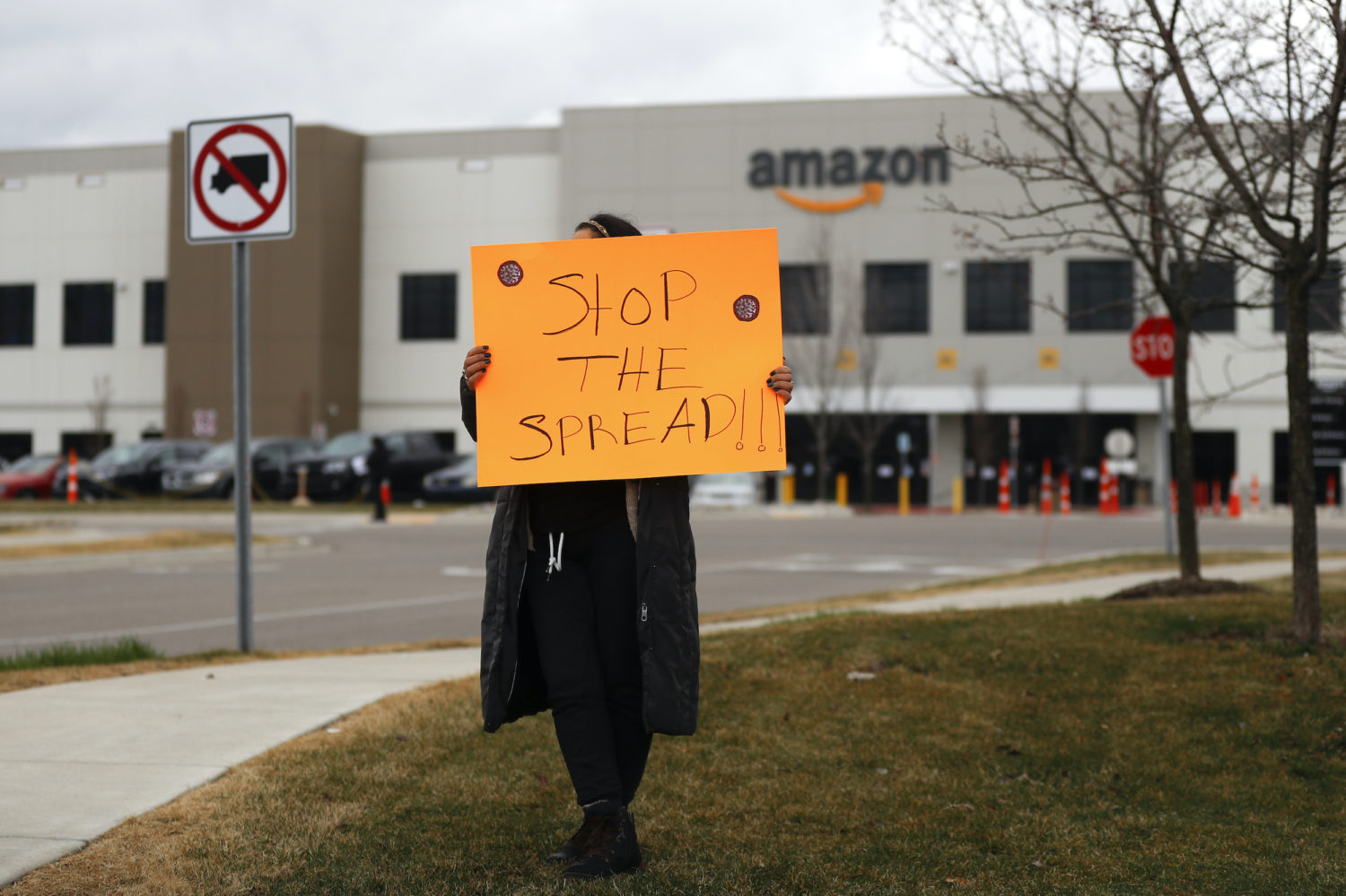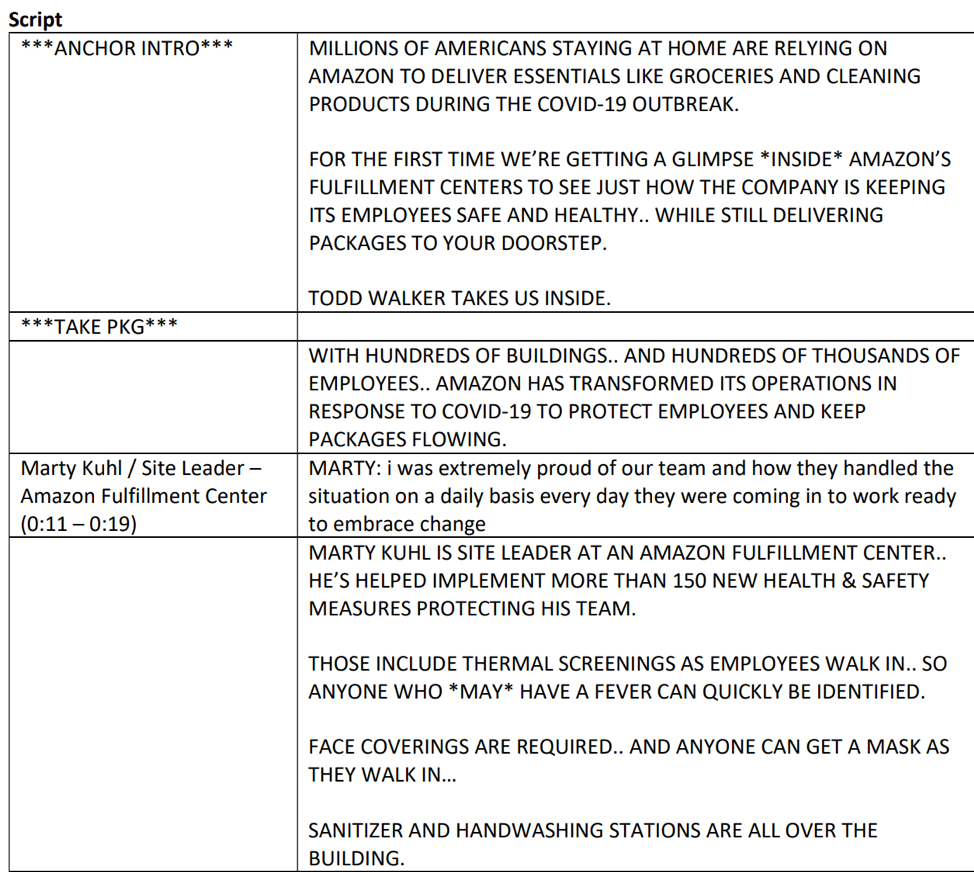 Covering COVID-19 is a daily Poynter briefing of story ideas about the coronavirus for journalists, written by senior faculty Al Tompkins. Sign up here to have it delivered to your inbox every weekday morning.
Covering COVID-19 is a daily Poynter briefing of story ideas about the coronavirus for journalists, written by senior faculty Al Tompkins. Sign up here to have it delivered to your inbox every weekday morning.
Today is Amazon’s annual shareholder’s meeting. The company got out in front of criticism that will arise in today’s meeting by distributing a news release that looks like a TV news story and that claims Amazon is spending billions of dollars to keep workers safe.
Almost a dozen TV stations ran at least some part of the video press release word-for-word without saying where it came from. It is not only an ethics issue, but the Federal Communications Commission has also made it clear that running unlabeled content of a political or controversial nature would result in a $10,000 fine.
Ouch.
In the TV business, these so-called video news releases, or VNRs, are so 1998. Frankly, I have not heard of anybody using such things on the air in years because they have been around since the early 1990s and have been loudly condemned as commercials disguised as news stories.
But there they are, aggregated on a website run by a “progressive media company” called Courier: station after station repeating the words scraped right off the Amazon press release.
Amazon released the script with a narrated “news package” (with the voice of Amazon spokesman Todd Walker) and included “news package elements without narration for local anchor voiceover.” And, sadly, some stations took advantage of that and ran it.
Amazon released the video, script and narration on BusinessWire.
While a couple of TV stations even promoted their news-release journalism on Twitter, other local TV reporters called it out.
Oklahoma City weekend mornings anchor Zach Rael said an Amazon public relations employee, who he is not naming, sent him this email pitching the press release as weekend content:
Interesting…here is the email sent directly to me from one of Amazon’s listed PR people.
(I blocked their name because I don’t feel it’s fair to single them out.) https://t.co/EICCJutMOl pic.twitter.com/FAQiV1kjOJ
— Zach Rael (@KOCOZach) May 26, 2020
Keep in mind that holiday weekends are typically lightly staffed so it would not be a surprise for newsrooms to be scraping for content.
VNRs became a hot topic 15 years ago when the George W. Bush administration produced videos that some TV stations ran without disclosing to viewers that they were produced by the State Department and at least 19 other federal agencies. It was around time that government-produced videos on all sorts of topics were seemingly everywhere.
Journalism organizations like the Radio Television Digital News Association have spoken to the problems that come with VNRs for years. It is not to say a station can never ethically use a company-supplied video or even a statement, but the public has to understand where the video came from and why we are using it rather than verifying the content with our own eyes and lenses. But even using the video with attribution does not release journalists from pointing out that Amazon’s safety claims are at odds with warehouse worker’s claims.
CNBC explained what is at stake at Wednesday’s shareholder meeting, which may give us some understanding about why Amazon worked hard to put its message about safety in front of the public:
Tensions have been growing between Amazon and warehouse workers nationwide, as the numbers of confirmed cases and deaths at its facilities have climbed. Warehouse workers have called for the company to put in place greater safety protections, including providing paid sick leave and closing down facilities where there are positive cases for additional cleaning.
Amazon has repeatedly declined to disclose how many warehouse employees have died from the coronavirus, but has confirmed eight deaths as they were reported by various media outlets. The company also hasn’t provided a total number of workers who have fallen ill from the virus, though one estimate from Jana Jumpp, an Amazon worker in Indiana, pegs the total number of cases at 900 employees nationwide.
In 2005, the FCC put broadcasters on notice that failure to reveal the sponsors of political or controversial VNRs could result in the fines up to $10,000 and the unheard-of penalties of license revocation or imprisonment of up to a year. (It was never clear who the FCC might send to prison, so perhaps it was thrown in to make the threat sound tougher.)
But the FCC has fined a station for a violation not much different from this Amazon VNR issue. A TV station was fined $4,000 for running video supplied by General Motors that referred to new models of cars that were coming out. Another station was fined for using a VNR that talked about the benefits of zinc in fighting colds and that included an interview with a doctor who mentioned Zicam, a medication. Zicam was behind the VNR.
Even though Amazon did not pay the stations to run their VNRs, the FCC says it does not matter. In fact, the FCC said that videos that are not directly selling a product but instead attempt to sway attitudes are more concerning.
The VNR is a reminder to us all that this is exactly the sort of thing that undermines the public’s trust in what they see, hear and read. Now is the time for us to remind ourselves that, particularly in a pandemic, journalists all sink and swim together. An attack on a handful of TV stations spreads faster than a virus to everyone that the public considers “the media.”
May this dustup be an inoculation for us all.
40,000 National Guard troops who answered the COVID-19 call may still lose benefits by one day
Memorial Day has come and gone and our political leaders again professed their adoration for members of the military. What they did not do is fix a scheduling problem that in a few weeks could cost 40,000 National Guard members education and retirement benefits.
For a couple of weeks, reports have circulated that the Trump administration would fix the problem, but it has not happened yet.
As it stands today, the administration’s orders call for the National Guard COVID-19 activation to end June 24. That is 89 days of activation. Guard members earn credit for days of activation but the credits only kick in after 90 days of duty.
130 senators and representatives have been calling on the president to extend National Guard members’ active duty — not just to help guard members earn the benefits, but also because states say they need the military to help control a second wave of illness.
Tens of thousands of them have been working full-time since early March on a wide range of sensitive and dangerous tasks, such as decontaminating nursing homes and setting up field hospitals, along with performing tests for the virus. They’ve provided a crucial backup for understaffed and underfunded state public health agencies trying to contain the pandemic.
The cost of the deployment is as much as $9 million per month for every 1,000 troops, according to the National Council of State Legislatures — an expense that states would have to shoulder should Title 32 expire. In addition, state deployments do not count toward federal education and retirement benefits.
The benefits are essentially service credits. In order to qualify for a pension at age 60, a guard member must have served for 20 years. But for every 90 days that guard members serve in a national emergency, the military allows them to move retirement up by three months. Also, after 90 days of service, guard members qualify for a 40% tuition payment for public universities.
If the Trump administration sticks to its 89-day deployment, a guard member could still qualify for the benefits if there is a second national emergency that calls them to duty, such as a hurricane or a second COVID-19 outbreak.
A soldier buried without ceremonies
One of our readers, Jonathan Roberts at the Johnson City (Tennessee) Press, followed up on an item I posted last week about how, during the pandemic, veteran cemeteries are only able to offer committal services and not the full military honors with honor guard, taps and a family gathering. In fact, nationwide, the waiting list for final services are stacking up so much that families may choose to do group ceremonies once they are allowed.
For now, a Department of Veterans Affairs website is posting the name of every veteran who is to be honored at a VA cemetery service when they begin again. The website log began in mid-April and is updated every day. As you look at it, you may be surprised by the sheer size of the list, by cemetery, and how much it grows every day.
That website gives you an idea of how huge the backlog for services will be once the pandemic passes.
Airbnb selloff: The dream is not so attractive these days
Airbnbs are in big trouble after a couple of months sitting vacant and the calendar ahead not looking much more promising.
With global travel screeching to a halt during the pandemic, a number of Airbnb hosts are planning to sell their properties — at an uncertain moment for the broader real estate market — or get rid of some of their rentals as well as the furniture they bought to deck out their homes. These desperate moves come as hosts face the possibility of losing thousands of dollars a month in canceled bookings while bills, maintenance costs and mortgage payments pile up. The sudden and painful whiplash for hosts highlights both the broader financial fallout from the pandemic and the potential risks of betting one’s livelihood on the staying power of newer tech platforms.
As the pandemic has stretched on, Airbnb’s business model has been thrown into question. After reportedly planning to make its splashy Wall Street debut this year, the company instead had to lay off about 25% of its workforce. At the same time, it has struggled to appease the hosts who are the backbone of its service. Airbnb announced in late March it would pay hosts 25% of what they would typically get back through their individual cancellation policies, but some hosts told CNN Business the policy didn’t go far enough to help, or that they received smaller payments than expected.
It is a disruption for the disrupted that sought to pressure hotel rates. But not only have bookings tanked, but small operators are having to absorb increased cleaning costs.
We’ll be back tomorrow with a new edition of Covering COVID-19. Sign up here to get it delivered right to your inbox.
Al Tompkins is senior faculty at Poynter. He can be reached at atompkins@poynter.org or on Twitter, @atompkins.








